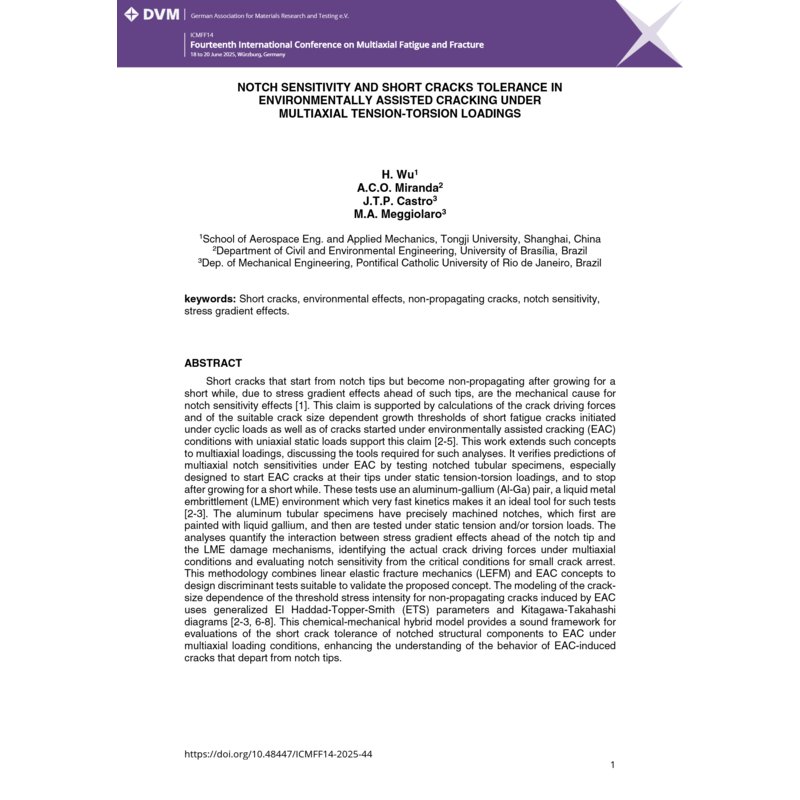- Online only



Even though in most practical structural designs notch sensitivity effects still are estimated using semi-empirical curves fit to only seven data points measured in the first half of the last century, they in fact are caused by an interesting stress analysis problem that nowadays can be solved using modern analytical and numerical tools. Indeed, notch sensitivity is due to the behavior of short cracks that initiate from notch tips but become non-propagating after growing for a short while, due to stress gradient effects ahead of those tips [1]. Calculations of the effects of such gradients on the crack driving forces can predict accurately the tolerance to short fatigue cracks initiated under uniaxial cyclic loadings. They also can predict well the behavior of short cracks initiated…

Datenschutzbedingungen (bearbeiten im Modul "Kundenvorteile")

Lieferbedingungen (bearbeiten im Modul "Kundenvorteile")

Rücksendebedingungen (bearbeiten im Modul "Kundenvorteile")
Even though in most practical structural designs notch sensitivity effects still are estimated using semi-empirical curves fit to only seven data points measured in the first half of the last century, they in fact are caused by an interesting stress analysis problem that nowadays can be solved using modern analytical and numerical tools. Indeed, notch sensitivity is due to the behavior of short cracks that initiate from notch tips but become non-propagating after growing for a short while, due to stress gradient effects ahead of those tips [1]. Calculations of the effects of such gradients on the crack driving forces can predict accurately the tolerance to short fatigue cracks initiated under uniaxial cyclic loadings. They also can predict well the behavior of short cracks initiated under environmentally assisted cracking (EAC) conditions under uniaxial static loads [2-4]. Recent advances in the mechanical modeling of notch sensitivity problems [5] have opened opportunities to extend such concepts to multiaxial loadings. This work aims to present two main contributions to this field. First, it discusses the analytical and numerical tools required for such analyses. Second, it verifies some predictions of multiaxial notch sensitivities under EAC by testing notched tubular tension-torsion test specimens, specially designed to start EAC cracks at their tips under static tension-torsion loadings, and to stop after growing for a short while. These tests use an Al-Ga pair, a liquid metal embrittlement (LME) environment whose very fast kinetics makes it an ideal tool for such verification tests [2-3].
The experimental setup involves Al tubular specimens with precisely machined notches subjected to static tension and/or torsion loads. The specimens are mounted on an MTS809 multiaxial fatigue testing machine with an onsite environmental chamber for temperature control, see Fig. 1. The notches are designed to start small cracks at their tips due to the LME agent (Ga) under linear elastic conditions, which will become non propagating after growing for a short while. The analysis explores the interaction between the stress gradient effects ahead of the notch tips and the LME mechanisms, identifying the actual crack driving forces under multiaxial conditions. The notch sensitivity is then quantified from the critical conditions for crack initiation and small crack growth and arrest. By extending the mechanical modeling principles to multiaxial problems, this work seeks to evaluate the short crack characteristic size under EAC conditions and its dependence on multiaxial stress states, expanding the semi-empirical and mechanical frameworks previously established for EAC notch sensitivity to the multiaxial case.
The methodology combines linear elastic fracture mechanics (LEFM) and EAC concepts to design discriminant tests suitable to validate experimentally the proposed concept. A generalized El Haddad-Topper-Smith (ETS) parameter [1] is used to model the crack-size dependence of the threshold stress intensity range for the behavior of non-propagating cracks induced by EAC. This parameter is calibrated from measurements of the crack initiation limit stress as well as the crack growth threshold in the aggressive medium. The role of Ga in reducing the material resistance is systematically assessed through a modified Kitagawa-Takahashi diagram, adapted for multiaxial loading and EAC environments.
The models offer a robust framework for predicting structural tolerance to EAC under complex loading, advancing understanding of EAC-induced cracks away from notch tips. These outcomes bridge traditional notch sensitivity models and multiaxial EAC resistance needs, providing practical insights for aerospace and marine applications.